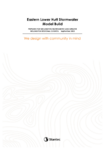Eastern Lower Hutt Stormwater Model Build
Search in document library
Purpose of the Report
To develop, validate, and calibrate an integrated stormwater model for Eastern Lower Hutt to support flood hazard mapping and district planning.
Geographic Area Covered
The model covers the Lower Hutt suburbs east of the Hutt River, from Wellington Harbour in the south to Pomare in the north, encompassing 31.5 km² of mostly flat floodplain and adjacent Eastern Hills.
Summary of Key Findings
The Eastern Lower Hutt Stormwater Model was developed by Stantec for Wellington Water Limited and Greater Wellington Regional Council. It integrates 1D and 2D hydraulic modelling using InfoWorks ICM software to simulate stormwater flows across the catchment. The model includes the full public stormwater network, major streams (Waiwhetū, Opahu, Awamutu), and overland flow paths. Hydrological parameters were derived from regional GIS layers using the SCS method. The model comprises 7,884 subcatchments, with nearly half under 0.1 ha. Approximately 240 km of stormwater pipes are included, with 90% of pipe inverts interpolated due to missing data. Topography was based on 1 m LiDAR data from 2013/2016, merged with GWRC terrain models and harbour bathymetry.
The model was validated against the February 2004 and November 2016 flood events using observed flood extents, photos, and GWRC flood level marks. It generally overestimates flood levels slightly, with over 70% of locations within 0.25 m of observed levels. Calibration focused on the Whites Line East gauge on the Waiwhetū Stream, using five events from 2004–2019. Sensitivity analysis showed the model is highly sensitive to rainfall increases, bridge blockages, and tidal boundary conditions.
Flood hazard maps were produced for current and future climate scenarios, including sea level rise and increased rainfall. Residual hazard scenarios modelled stopbank breaches at key locations. Maximum uncertainty maps were generated by combining worst-case scenarios. The model is suitable for district plan mapping and catchment-scale analysis, but detailed design requires local reassessment.
Recommendations include updating asset data, investigating LiDAR accuracy for small ponds, using maximum uncertainty results for conservative planning, and adding freeboard for development.
